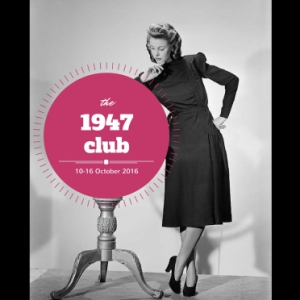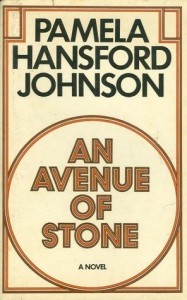 Karen of Kaggsysbookishramblings is a voracious reader, a sociable blogger, and an indefatigable co-organizer of “The 1947 Club.” What is the 1947 Club? Bloggers and other readers agree whimsically to read and post on books published in 1947–any and all books published in 1947!
Karen of Kaggsysbookishramblings is a voracious reader, a sociable blogger, and an indefatigable co-organizer of “The 1947 Club.” What is the 1947 Club? Bloggers and other readers agree whimsically to read and post on books published in 1947–any and all books published in 1947!
It is not so much that I’m unsociable as absent-minded, so I was pleasantly surprised this year when I managed to read a couple of Viragos for Virago month and two books for Women in Translation Month. “So, Go for it, Kat! You can read a book from 1947,” I told myself. So It’s halfway through the 1947 week, and I was about to embark on a book published the wrong year. Yup. I have this thing: dyslexia with numbers.
Now that I’m on the right year, I would like to recommend one of my favorite books of 1947 (and of all time), An Avenue of Stone by Pamela Hansford Johnson.
If you don’t know Pamela Hansford Johnson’s stunning novels, you are missing out. Best known as Dylan Thomas’s girlfriend and C. P. Snow’s wife, she had enough talent and merciless observations to put those two boys in the shade. A few years ago I interviewed her biographer Wendy Pollard here. I appreciated Pollard’s serious work and hope it revived interest in Johnson. And it is a very good sign that Bello Pan has reissued Johnson’s books in paperback and as e-books. (Unfortunately the e-books aren’t available in the U.S.)
 And now I am going to cheat a bit by posting old notes on An Avenue of Stone from 2009.
And now I am going to cheat a bit by posting old notes on An Avenue of Stone from 2009.
Pamela Hansford Johnson’s Helena trilogy, of which An Avenue of Stone is the brilliant centerpiece, shows Johnson at the height of her powers. The first book in the trilogy, Too Dear for My Possessing (1940), is a coming-of-age novel: Claud, the narrator, bickers with and competes against his beautiful, controlling, often wicked stepmother Helena. After his father’s death, his life is inextricably intertwined with Helen’s, for better or worse.
 To read the second novel first, An Avenue of Stone (1947), is both an advantage and a liability. Each novel is self-contained, so the order doesn’t matter. And I loved An Avenue of Stone so much that I went on to read the other two. Johnson says in the introductions to the American reprints that she was learning her craft when she wrote the first book, Too Dear for My Possessing (1940). The second and the third novels, An Avenue of Stone and A Summer to Decide, published in 1947 and 1948 respectively: “So, between books 1 and 2, I had seven years of learning to write…
To read the second novel first, An Avenue of Stone (1947), is both an advantage and a liability. Each novel is self-contained, so the order doesn’t matter. And I loved An Avenue of Stone so much that I went on to read the other two. Johnson says in the introductions to the American reprints that she was learning her craft when she wrote the first book, Too Dear for My Possessing (1940). The second and the third novels, An Avenue of Stone and A Summer to Decide, published in 1947 and 1948 respectively: “So, between books 1 and 2, I had seven years of learning to write…
She continues in the intro to Avenue, “I was no longer giving way to a too-easy romanticism; I was able to give the book a rather more solid structure.”
An Avenue of Stone is an unforgettable masterpiece. In this brilliant novel, set at the end of World War II, the narrator, Major Claud Pickering, an art historian and writer, describes the volatile relationships of his stepmother, Helena, amidst the deprivations of rationing and the disintegrating class boundaries of the postwar society.
The novel begins with Helena’s ramblings about class.
“As a class,” Helena said, “we are doomed…”
 Helena, a former chorus girl who married into the upper class and has established herself as a glittering hostess, loves to talk about the rebellion of the proles. As the novel begins, the sixty-something Helena is entertaining guests with outrageous complaints about the collapse of society, illustrated by exaggerated anecdotes about rude bus conductors and insolent shop girls. After her second husband, Lord Archer, dies, leaving the majority of his money to Helena’s daughter, Charmian, and, shockingly, to his former lovers, Helena can no longer live on the grand scale to which she is accustomed. She is persuaded to let her hunky chauffeur go and move into an apartment with Claud and Charmian. Helena, unused to living without admiration, becomes vulnerable to a kind of asexual love affair with Johnny Field, an irritatingly self-denigrating young man, whom Claud introduces into the household, assuring her that Johnny needs rest and “does nothing but read.”
Helena, a former chorus girl who married into the upper class and has established herself as a glittering hostess, loves to talk about the rebellion of the proles. As the novel begins, the sixty-something Helena is entertaining guests with outrageous complaints about the collapse of society, illustrated by exaggerated anecdotes about rude bus conductors and insolent shop girls. After her second husband, Lord Archer, dies, leaving the majority of his money to Helena’s daughter, Charmian, and, shockingly, to his former lovers, Helena can no longer live on the grand scale to which she is accustomed. She is persuaded to let her hunky chauffeur go and move into an apartment with Claud and Charmian. Helena, unused to living without admiration, becomes vulnerable to a kind of asexual love affair with Johnny Field, an irritatingly self-denigrating young man, whom Claud introduces into the household, assuring her that Johnny needs rest and “does nothing but read.”
At first she uses Johnny as a lackey to pass appetizers at parties and install linoleum at her cottage , but later she is fascinated by him and insists that she can’t live without him. Claud and Charmian can’t bear the situation and move out. Johnny the unlikely gigolo, is, surprisingly, a magnet to older women. One of Lord Archer’s former lovers, Mrs. Olney, a lamp shade maker, also tries to lure him to live with her.
Claud’s observations of this unlikely triangle are the center of the novel. But his wry observations keep him in the forefront, and it is for his voice that we read. This very slightly reminds me of Anthony Powell’s novels.

PHJ is a woman on my wishlist (and I’m sure I own at least one of her books!) High praise indeed – and so glad you could find a book from 1947! 🙂
LikeLike
Oh, she is one of my favorite writers! It is hard to find a 1947 book when you don’t plan it but I cobbled together this post from notes shortly after I visited your blog and realized I had the wrong room. I love your blog and appreciate all your support so am glad I found one.
LikeLiked by 1 person
You remind me that I must read more PHJ soon I have some of the Bello editions on my kindle.
LikeLike
Those Bello editions are great. Why the Johnsons aren’t available as e-books here I don’t know. The Mary Hockings and all the others are.
LikeLike
Oh what a shame.
LikeLike
I read this book some time ago and liked it. It was an old edition that had belonged to Mother. I did not know it was being reissued. And yes, it reminded me of A Dance to the Music of Time – but there are glittering hostesses in Powel’s world.
The only thing I shall add (as usual) is that I still don’t understand why there need be such stupid things as the 1947 Book Club or other “challenges” or “events”. This gives me the sense of a herd stamping in the same direction with no personality and no individual feelings or thoughts. But as it seems sociable to do so, I must be an a-social person…
LikeLike
Am very glad you like Johnson, too. Bello has reissued them, but the books are not available here (darn!). Fortunately I have collected many used copies over the years.
Oh, well, the 1947 thing seems pure whimsy to me, but I must confess I am not sure how it started.
LikeLike